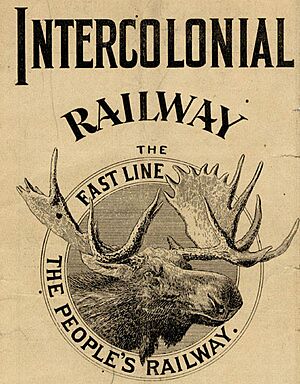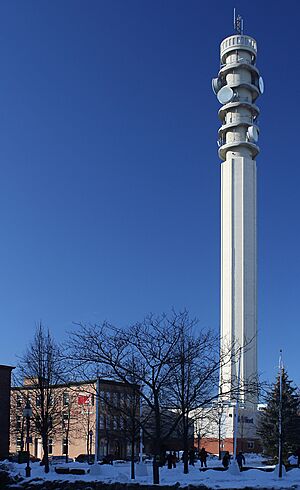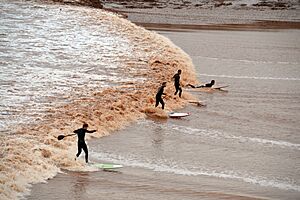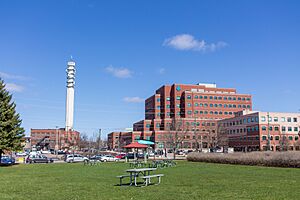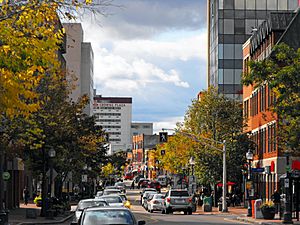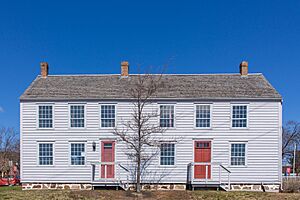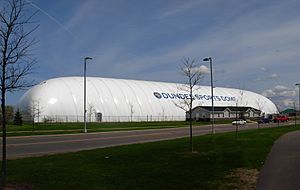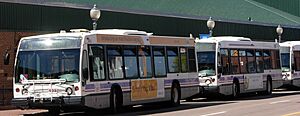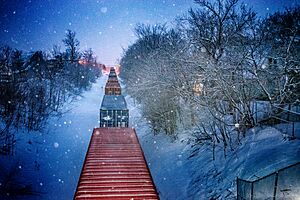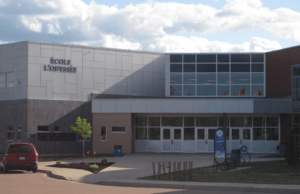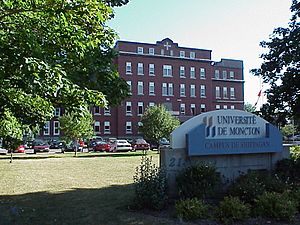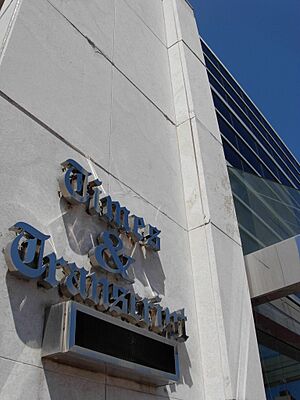Moncton facts for kids
Quick facts for kids
Moncton
|
|||
|---|---|---|---|
|
City
|
|||
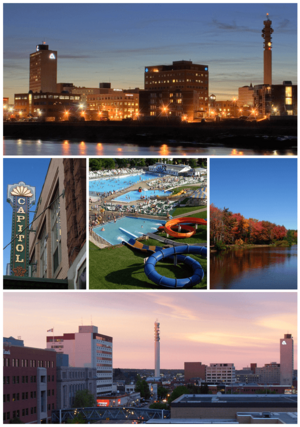
From top, left to right: Moncton skyline at night, the Capitol Theatre, Magic Mountain, Centennial Park, and Downtown Moncton at dusk
|
|||
|
|||
| Nickname(s):
"Hub City"
|
|||
| Motto(s): | |||
| Country | Canada | ||
| Province | New Brunswick | ||
| County | Westmorland | ||
| Parish | Moncton Parish | ||
| First settled | 1733 | ||
| Founded | 1766 | ||
| Incorporated | 1855, 1875 | ||
| Named for | Robert Monckton | ||
| Government | |||
| • Type | Council-Manager | ||
| Area | |||
| • City | 140.67 km2 (54.31 sq mi) | ||
| • Urban | 110.73 km2 (42.75 sq mi) | ||
| • Metro | 2,562.47 km2 (989.38 sq mi) | ||
| Highest elevation | 70 m (230 ft) | ||
| Lowest elevation | 0 m (0 ft) | ||
| Population
(2021)
|
|||
| • City | 79,470 | ||
| • Density | 564/km2 (1,460/sq mi) | ||
| • Urban | 119,785 | ||
| • Urban density | 1,081.8/km2 (2,802/sq mi) | ||
| • Metro | 157,717 | ||
| • Metro density | 61.5/km2 (159/sq mi) | ||
| • Demonym | Monctonian | ||
| Time zone | UTC−4 (AST) | ||
| • Summer (DST) | UTC−3 (ADT) | ||
| Canadian Postal code |
E1A-E1G, E1K
|
||
| Area code | 506 and 428 | ||
| NTS Map | 21I2 Moncton | ||
| GNBC Code | DADHJ | ||
| Highways | |||
| GDP (Moncton CMA) | CA$6.9 billion (2016) | ||
| GDP per capita (Moncton CMA) | CA$47,959 (2016) | ||
Moncton is the biggest city in the Canadian province of New Brunswick. It's located in the Petitcodiac River Valley, right in the middle of the Maritime Provinces. People often call it the "Hub City." This is because it's a central spot for transportation, especially for trains and roads, connecting different parts of the Maritimes.
In 2021, about 79,470 people lived in Moncton. If you include the surrounding areas, the population was over 171,608 in 2022. This makes it one of the fastest-growing cities in Canada!
Moncton was first settled in 1733. It was officially founded in 1766 by German immigrants from Philadelphia. At first, it was a farming community. It became a town in 1855 and was named after Lt. Col. Robert Monckton. He was a British officer who captured a nearby fort.
In the 1840s, Moncton became known for building wooden ships. But this industry collapsed in the 1860s. The town even lost its official status for a while. However, Moncton bounced back in 1875 thanks to the growing railway industry. The Intercolonial Railway of Canada made Moncton its main office in 1871. Moncton was a "railway town" for over 100 years until the train repair shops closed in the late 1980s.
Moncton has faced tough times twice, but it always recovers. That's why its motto is Resurgo, which means "I rise again" in Latin. Today, Moncton has a strong and varied economy. It's still important for transportation and shopping. It also has strong education, health care, and technology industries. Moncton's economy is so strong that its unemployment rate is usually lower than the rest of Canada.
Contents
Moncton's Story
The first people to settle in the Moncton area were the Acadians in the early 1700s. They built a farming community and called it Le Coude, meaning "The Elbow." This name came from a sharp bend in the river nearby.
In 1755, British forces captured Fort Beausejour. This meant the Moncton area came under British control. Later that year, the Acadians were forced to leave their homes. This event is known as the "Great Upheaval."
In 1766, German settlers from Pennsylvania arrived. They rebuilt the farming community and renamed it "The Bend." For almost 80 years, it remained a small farming village.
A big change happened in 1847 when Joseph Salter started a large shipyard. This shipyard employed about 400 workers. The town grew around it, offering services to support the shipbuilding. Because of this success, "The Bend" became the town of Moncton in 1855. Joseph Salter became its first mayor.
However, steam-powered ships became popular, ending the need for wooden ships. The shipyard closed in 1858, and Moncton faced hard times. The town even lost its official status in 1862.
But Moncton's struggles didn't last long. In 1871, the city was chosen as the main office for the Intercolonial Railway of Canada (ICR). This was a huge moment for Moncton. The railway brought new jobs and growth. In 1875, Moncton became a town again. By April 23, 1890, it had grown enough to become a city.
Moncton continued to grow quickly in the early 1900s. It became a major railway hub. The Canadian National Railways (CNR) made Moncton its main repair facility for the Maritimes. During World War II, the Canadian Army built a large supply base here. At its peak in the 1950s, the railway employed nearly 6,000 people in Moncton.
In the 1960s, the Trans-Canada Highway was built near Moncton. The Université de Moncton was also founded in 1963. This university became very important for Acadian culture.
The late 1970s and 1980s were difficult. Many big employers, like the CNR shops, closed down. Thousands of people lost their jobs.
But Moncton bounced back again in the 1990s. New technology companies, especially call centres, moved in. They liked Moncton's bilingual (English and French-speaking) workforce. This amazing recovery is sometimes called the "Moncton Miracle."
Since the 1990s, Moncton has kept growing. It has hosted big events like the Francophonie Summit in 1999 and a Rolling Stones concert in 2005. In 2002, Moncton became Canada's first officially bilingual city.
Moncton's Location and Climate
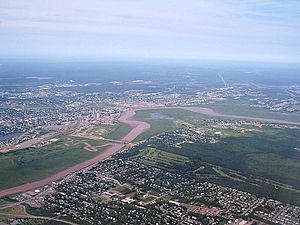
Moncton is in southeastern New Brunswick. It's right in the middle of the Maritime Provinces. The city sits on the north bank of the Petitcodiac River. The river makes a sharp bend here, changing direction from west-east to north-south. This bend is why early settlers called the area "The Elbow."
The Petitcodiac River valley in Moncton is wide and mostly flat. Moncton used to be at the point where ships could travel up the river. However, a causeway (a raised road over water) built in 1968 made the river channel fill with silt. This made it impossible for ships to pass. In 2010, the causeway gates were opened to help the river flow better.
The Tidal Bore Mystery
The Petitcodiac River has a special natural event called a tidal bore. This is a wave that travels up the river when the tide comes in. It happens because of the huge tides in the Bay of Fundy.
Before the causeway was built, the bore was very impressive. It could be 1 to 2 meters high and stretch across the entire river. This wave happened twice a day and made a loud roaring sound. It was a popular tourist attraction. After the causeway, the bore became much smaller. But since the gates were opened in 2010, the bore has started to grow bigger again!
Weather in Moncton
Moncton's climate is mostly continental, meaning it has clear seasons. Winters are usually cold but sunny. Major snowfalls can happen from big ocean storms. Spring often arrives a bit later because of the cold air from melting sea ice in the nearby Gulf of St. Lawrence.
Summers are warm, sometimes hot, and can be a bit humid. It doesn't rain too much, especially in late July and August. Autumn stays mild until late October. The first snow usually falls in late November.
The highest temperature ever recorded in Moncton was 37.8°C (100°F). The coldest was -37.8°C (-36°F).
Moncton's City Life
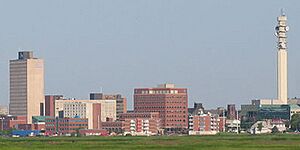
Moncton is generally a city with lower buildings. But its skyline shows different building styles from many years. The most noticeable structure is the Bell Aliant Tower. This 127-meter-tall tower was built in 1971. It's the tallest free-standing structure in all of Atlantic Canada!
Assumption Place is a 20-story office building. It's 81 meters tall and one of the tallest buildings in the province. The Blue Cross Centre is a large, nine-story office building downtown. It's home to Medavie Blue Cross and the Moncton Public Library.
Green Spaces

Moncton has many great parks. Centennial Park is very popular. It has trails for skiing and hiking, a huge playground, and sports facilities like tennis courts. There's also a treetop adventure course and a football stadium called Rocky Stone Field.
Other important parks include Mapleton Park and Irishtown Nature Park. Irishtown Nature Park is one of the largest urban nature parks in Canada. There are also many smaller neighborhood parks. Bore View Park offers views of the Petitcodiac River. Victoria Park downtown has flower gardens and a fountain. Moncton also has a large network of trails for hiking and biking. The Riverfront Trail is part of the Trans Canada Trail.
People and Languages
In 2021, Moncton had about 79,470 people. The larger Moncton area, including Dieppe and Riverview, had over 157,717 people. Moncton's urban area is the third largest in Atlantic Canada.
Moncton is known for being a bilingual city. This means many people speak both English and French. About 58.5% of residents speak English as their first language. About 27.3% speak French as their first language. And about 46% of the city's population can speak both English and French! In 2002, Moncton became the first officially bilingual city in Canada. This means all city services and information are available in both languages.
Many people from different backgrounds live in Moncton. In 2021, about 10.9% of the population were immigrants, meaning they were born outside Canada. The largest groups of immigrants came from the Philippines, India, and the United States.
How Moncton Makes Money
Moncton's economy is strong because of its central location. It's a key spot for business, transportation, and shopping in the Maritimes. Many people live within a three-hour drive of the city, making it a great place for businesses.
Important industries in Moncton include insurance, technology, education, and health care. The city's two hospitals employ over five thousand people. There's also a growing high-tech sector with companies like Nanoptix and International Game Technology.
Moncton's economy is so strong that it has received national attention. In 2004, Canadian Business magazine called it "The best city for business in Canada."
Because many people in Moncton speak both English and French, it's a good place for federal government offices and call centres. There are 37 call centers in the city, employing over 5,000 people.
Many large companies have their main offices in Moncton. These include Atlantic Lottery Corporation, Assumption Life Insurance, and Medavie Blue Cross Insurance. TD Bank also opened a new banking services center here, creating over 1,000 jobs.
Moncton has three big industrial parks. These parks are home to many warehouses and trucking facilities. Molson Coors opened a new brewery in the Caledonia Industrial Park in 2007.
A new four-lane bridge, the Gunningsville Bridge, opened in 2005. It connects downtown Riverview directly to downtown Moncton. This bridge has helped the downtown area grow. A new 8,800-seat arena, the Avenir Centre, opened in 2018.
Shopping is also a huge part of Moncton's economy. Big shopping areas like Champlain Place and the Wheeler Park Power Centre attract many shoppers and tourists.

Tourism is important too, thanks to attractions like the Magnetic Hill. This is a fun optical illusion where your car seems to roll uphill! The Magnetic Hill area also has a golf course, a big water park called Magic Mountain, a zoo, and an outdoor concert area. A large casino and hotel complex opened at Magnetic Hill in 2010.
Culture and Arts

Moncton's main place for cultural entertainment is the Capitol Theatre. This beautiful 800-seat theatre was built in the 1920s. It hosts many plays, concerts, and performances by groups like Symphony New Brunswick and the Atlantic Ballet Theatre of Canada.
The Atlantic Ballet Theatre is based in Moncton and performs across Atlantic Canada and sometimes internationally. Théâtre l'Escaouette is a French-speaking theatre company with its own performance space.
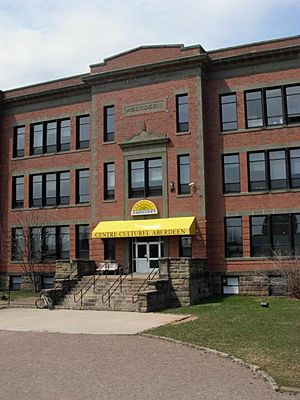
The Aberdeen Cultural Centre is a big Acadian cultural hub. It has many studios and galleries, including the Galerie Sans Nom, a major art gallery.
Moncton has two main museums. The Moncton Museum at Resurgo Place has been updated to include the Transportation Discovery Centre. This center has hands-on exhibits about the city's history with transportation. The Musée acadien is at the Université de Moncton.
Moncton also has historic buildings. The Free Meeting House was built in 1821. The Thomas Williams House, built in 1883, is now a research center. The Treitz Haus, built in 1769, is the oldest building in New Brunswick.
Moncton hosts the the Frye Festival, an annual bilingual literary festival. It celebrates famous literary critic Northrop Frye, who was from Moncton. Writers and poets from around the world attend this event in April.
Another big event is the Atlantic Nationals Automotive Extravaganza in July. It's the largest gathering of classic cars in Canada. Other fun events include The Atlantic Seafood Festival and The HubCap Comedy Festival.
Sports and Fun
Sports Facilities
The Avenir Centre is a modern 8,800-seat arena. It hosts big concerts and sports events. It's home to the Moncton Wildcats hockey team and the Moncton Magic basketball team.
The CN Sportplex is a huge recreation area. It has ten baseball fields, six soccer fields, and an indoor rink complex with four ice surfaces. The Hollis Wealth Sports Dome is a large indoor building. It's big enough for year-round football, soccer, and golf.
The CEPS at Université de Moncton has an indoor track and a swimming pool. The new Moncton Stadium, also at the university, was built for the 2010 IAAF World Junior Championships in Athletics. It can seat 10,000 people and can be expanded for bigger events.
Sports Teams
Moncton has several sports teams. The Moncton Wildcats play major junior hockey in the Quebec Maritimes Junior Hockey League (QMJHL). They won the league championship in 2006 and 2010.
The Moncton Magic is a professional basketball team in the National Basketball League of Canada. The Moncton Fisher Cats play baseball in the New Brunswick Senior Baseball League. The Moncton Mustangs play football in the Maritime Football League.
The Université de Moncton also has many university sports teams, including hockey, soccer, and volleyball.
Major Events
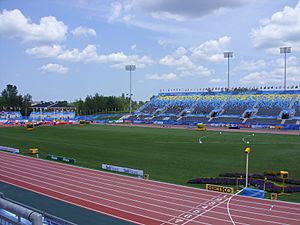
Moncton has hosted many big sports and entertainment events.
- The 2006 Memorial Cup (hockey championship)
- The World Men's Curling Championship in 2009
- The 2010 IAAF World Junior Championships in Athletics
- Several CFL regular season games (the first neutral site game in CFL history was here in 2010)
- Moncton was one of six Canadian cities to host the 2015 FIFA Women's World Cup.
- The 2023 World Junior Ice Hockey Championships (co-hosted with Halifax)

Getting Around Moncton
By Air

Moncton has its own airport, the Greater Moncton Roméo LeBlanc International Airport (YQM). It was named after former Canadian Governor General Roméo LeBlanc in 2016. The airport serves about 677,000 passengers each year. It's the second busiest airport in the Maritimes for passengers and the 10th busiest in Canada for cargo.
You can fly to major Canadian cities like Halifax, Montreal, Ottawa, and Toronto from here. During certain seasons, there are direct flights to sunny destinations in Cuba, Mexico, and Florida. Big cargo companies like FedEx and UPS also have their Atlantic Canadian bases here. The airport is also home to the Moncton Flight College, one of Canada's largest pilot training schools.
By Road
Moncton is located on Route 2 of the Trans-Canada Highway. This highway connects Moncton to Nova Scotia in the east and to Fredericton and Quebec in the west. Other important highways also meet near Moncton, connecting it to places like Shediac, northern New Brunswick, and Saint John.
Wheeler Boulevard (Route 15) acts like a ring road within the city. It helps traffic move around Moncton.
Public Transportation
The Greater Moncton area has a public bus service called Codiac Transpo. It operates 40 buses on 19 routes across Moncton, Dieppe, and Riverview.
Maritime Bus provides bus service between cities. Moncton is a major hub for this service. You can take a bus from Moncton to other big cities in New Brunswick, as well as Charlottetown, Halifax, and Truro.
By Train
Canadian National Railway handles freight trains in Moncton. Even though the railway's presence is smaller now, it still has a large train yard and cargo facility here. Moncton is also still the regional headquarters for Atlantic Canada.
For passengers, Via Rail Canada's train, the Ocean, stops at the Moncton railway station three days a week. You can take this train to Halifax or Montreal, Quebec. The train station also serves as the terminal for the Maritime Bus service.
Learning in Moncton
Moncton has many schools for students of all ages. There are both French-speaking and English-speaking schools. For high school, some of the English schools include Moncton High, Harrison Trimble, and Bernice MacNaughton.
For higher education, Moncton has:
- The Université de Moncton: This is a public university and the largest French-speaking university in Canada outside of Quebec.
- Crandall University: A private Christian university.
- The University of New Brunswick has a campus in Moncton for nursing degrees.
- The New Brunswick Community College (Moncton campus) and the Collège communautaire du Nouveau-Brunswick offer training in trades and technologies.
- Moncton Flight College: One of Canada's oldest and largest flight schools for pilots.
- McKenzie College: Specializes in graphic design, digital media, and animation.
- Oulton College: A private college offering programs in nursing, business, and more.
Media and News
Moncton's daily newspaper is the Times & Transcript. It's the most widely read daily newspaper in New Brunswick. There's also L'Acadie Nouvelle, a French newspaper.
The city has 17 radio stations, offering different types of music and shows. Eleven are English and six are French.
Rogers Cable has its main offices and production facilities in Moncton. The French-language part of the CBC, Radio-Canada, has its Atlantic Canadian headquarters in Moncton. There are also other TV stations representing major national networks.
Famous People from Moncton
Many notable people have come from Moncton, including:
- Gordie Drillon: A Hockey Hall of Famer.
- Russ Howard: A World and Olympic champion curler.
- Northrop Frye: A famous literary critic.
- Roméo LeBlanc: A former Governor General of Canada.
- Robb Wells: The actor who plays Ricky on Trailer Park Boys.
- Julie Doiron: An indie rock musician.
- Antonine Maillet: A famous French-speaking author.
- Sidney Crosby: The Canadian hockey star, who graduated from a Moncton high school.
Sister Cities
Moncton has two sister cities:
- Lafayette, Louisiana, United States
- North Bay, Ontario, Canada
See also
 In Spanish: Moncton para niños
In Spanish: Moncton para niños







